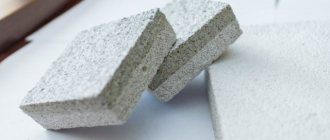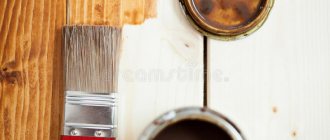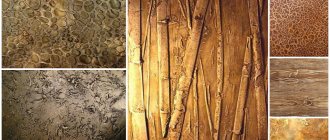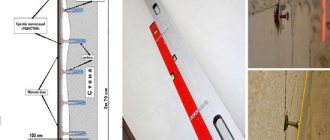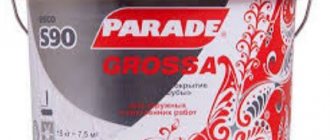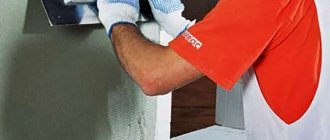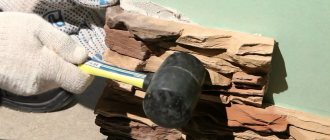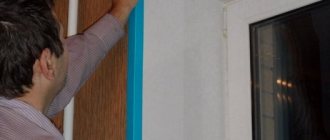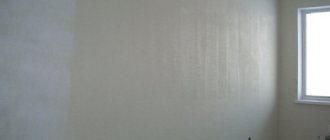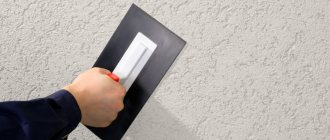Facade decorative plaster is a variety of plaster mixtures designed for finishing external walls, plinths, decorating retaining walls, gazebos and fences. The external decoration of the house may not be as intricate as the decor of the premises, but it is no less important, because the house represents its owners to everyone who happens to be nearby. But the main thing is the pleasure the owner feels when looking at his home. Decorative plaster of a facade is a special area of plastering work associated with the quality of the materials used, the scope of work, and production conditions.
Facade plaster for external use: distinctive features of the material
After completion of construction work, they begin to decorate the external walls of the building. High-quality cladding not only creates a presentable appearance of the building, but also protects the structure from the negative effects of precipitation, sunlight and mechanical damage. Facade plaster is the most popular material, about which you can find out in detail in this article.
Coating with facade plaster is an important step in finishing the external walls of a building.
Tips for working with plaster outdoors
Facade finishing is carried out under the following weather conditions:
- at a temperature not lower than +5оС and not higher than +30оС (this does not apply to winter plasters),
- in dry weather,
- at air humidity not higher than 70%.
In dry, hot weather, the plaster should be sprayed with water to prevent it from cracking. Plastering work should begin when several days without rain are expected. The treated area should be protected from sunlight.
Preparing the surface with façade putty for exterior work
Before proceeding to the final cladding of the external walls of the building, you should prepare the base using façade putty. It is designed for leveling surfaces made of concrete, stone, brick, foam blocks, gas blocks, gypsum boards and other materials. Facade putty for external work must have moisture resistance, frost resistance, vapor permeability and elasticity.
Facade plaster for external use helps protect the façade of a building from negative weather conditions.
There are starting and finishing façade putties.
The starting mixture is used for lower finishing of the base. Thanks to its coarse-grained structure, it is able to smooth out irregularities and differences. Used to seal chips and cracks. The result is a solid foundation. The working solution should resemble sour cream in consistency. The putty is applied in a layer of no more than 1.5 cm. Bark beetle plaster: characteristics, advantages and disadvantages (read more)
Finishing putty, which has a finely dispersed structure, is used for the final leveling of the base and provides a smooth, even surface for subsequent decorative cladding. The working solution is prepared more liquid than the starting mixture. The layer thickness should not be more than 4 mm.
Depending on the composition, the putty can be cement or polymer. Cement compositions have increased resistance to moisture and low temperatures. The starting cement mixtures contain quartz sand, and marble dust or ground quartz sand is added to the finishing putty. This is an unpretentious and inexpensive option, however, cracks may appear on the surface as the building shrinks. Popular brands of cement putties are Kreisel 662, SCANMIX TT, Knauf Multi-Finish, Plitonit and Facade.
Properly carried out stages of external plastering can achieve a high level of sound and heat insulation of walls.
Polymer putties, which contain polymer binders, can be acrylic or latex. Acrylic mixtures are moisture-resistant, elastic and plastic due to the main component – acrylic. This plaster is applied to a pre-primed concrete or foam concrete surface in a layer of 1-3 mm.
Latex putty, made from latex, is produced in the form of a paste that is odorless and does not emit harmful substances. This mixture has high plasticity, which eliminates the formation of cracks after it dries. Despite the high cost, it creates a durable coating. The most popular brands of polymer putties are SCANMIX LH STANDART, Bolars, Parade Classic.
Now you can proceed directly to the decorative design of the walls of the building, using facade plaster for exterior work.
Depending on the type of plastering work, it is recommended to use a reinforcing mesh to improve adhesion.
Do-it-yourself technology for plastering external walls
First, let's look at how to level and prepare external walls for applying decorative finishes.
Preparing the surface of the building facade
- Remove old finish.
- Clean the walls with a stiff steel brush.
- Inspect the surface to identify cracks and dents (roughness on the wood, burrs), etc. If there are any, clean them with sandpaper.
- Wash the wall with a damp sponge (with soap if necessary) and dry.
- Use a plumb line or level to check the verticality of the walls.
It is recommended to impregnate wooden facades with an antiseptic solution. If the walls are made of brick, stone, or aerated concrete blocks, then use empty masonry (with incomplete filling of the seams on the front side). This will ensure better adhesion of the wall surface to the plaster. If this has not been done, then before plastering, jointing is carried out (the seams are deepened with a chisel and hammer by 1 cm and cleaned with a brush). On concrete walls, with an ax or perforator, notches are made with a depth of 5 mm and a length of 5 to 10 cm in increments of no more than 4 cm.
jointing and notches for plaster
To improve the adhesion of the plaster to the surface of the facades, a primer is first applied. Its composition is selected taking into account the nature of the wall surface (concrete, wood, brick, etc.). The primed walls are left to dry for a day.
How to plaster: stages of applying a leveling layer
To obtain a good result, the plaster mixture is applied in three layers:
- Spray (starting) - from 3 to 9 mm (depending on the nature of the surface, a thicker layer is needed on wood).
- Ground - from 7 to 8 mm, if the plaster contains gypsum, then 9 - 12 mm.
- Covering (finishing) - from 2 to 4 mm.
To strengthen the facades and ensure rigid adhesion of the leveling layer, the plaster mixture is applied to the reinforcing mesh. To do this, after the primer has dried, apply the first layer of plaster and embed the mesh in it. Wooden facades can be reinforced with the same mesh or shingles - narrow wooden slats nailed diagonally crosswise. If the walls are insulated with mineral wool or similar insulation, then an adhesive solution is applied to it to fix the mesh. For example, ARMIERUNGS-GEWEBEKLEBER 215, PALADIUM PalafiX 402, Glims KF and others.
The procedure for plastering facade technology:
- The reinforcing mesh is installed on the street wall or on the insulation.
- If necessary, guide beacons made of metal profiles are attached. They are fixed to the wall with plaster mortar, and verticality is checked with a level.
- Apply the plaster mixture with a spatula or paint bucket, starting from the bottom and gradually moving upward. With the machine plastering method, a compressor and a pneumatic bucket are used for this.
- The applied layer is leveled using the rule. When using beacons, the rule rests on two guides and rises up, leveling the plaster layer.
- The second layer begins to be applied after a day. On the fresh layer you need to make notches or grooves to ensure better adhesion to the finish. You can use a notched trowel for this.
- After another day, apply the last layer - the covering. Dilute the plaster for it to a creamy consistency.
- After the finishing layer has dried, use a special trowel to grout. Press the device tightly against the surface, making circular movements clockwise. After processing the entire facade, rub it again in a straight line. If you need to achieve a perfectly flat surface, then wrap the grater in felt or felt.
Grout
If the decoration of the facade is carried out on the basis of leveling plaster, then immediately after applying the last layer, without waiting for it to dry, they begin to create a pattern or relief.
To do this, use special rollers with patterns, stencil stamps or a trowel. Options for drawings can be very diverse. Stamps are not very convenient, since they have to be washed frequently, and the expression of the design in different places is not the same due to different pressure forces. With a trowel, you can create a stone texture on the wall by simply making chaotic movements with it. If the plaster is planned to be painted, then after creating the texture and drying it is primed again and after that the paint is applied.
Facade plaster: varieties and famous brands
Decorative plaster for exterior use differs from facing materials intended for interior use. These mixtures contain additives that give the material plasticity, strength, moisture resistance and frost resistance.
When wondering how to choose facade plaster for exterior work, you need to pay attention to the material’s compliance with the following requirements:
- resistance to temperature changes;
- presence of water-repellent properties;
- increased degree of vapor permeability;
- sufficient strength to protect the building facade from mechanical damage;
- the coating must create sound and heat insulation;
- increased resistance to harmful radiation;
- the presence of decorative characteristics of the composition.
Plaster mixtures can be purchased either ready-made or in powder form, which must be diluted yourself.
Any external finishing creates additional thermal insulation of the building. However, for thin walls you should choose the so-called warm plaster for external use, which will contain a special filler. This can be perlite, polystyrene foam, vermiculite, sawdust or foam glass. They increase the thermal insulation properties of the finishing mixture. Thus, a 3 cm layer of plaster can replace the characteristics of 15 cm thick brickwork.
An additional soundproofing layer is provided by the exterior plaster of the house. To do this, it must contain pumice, magnesite or cement with slag or pumice. These porous components are capable of partially absorbing noise.
On a note! If the building is exposed to high noise levels, external plaster, as a reliable sound insulator, is ineffective. You should additionally use mineral wool or foam boards. Also, you can perform warm plaster for the facade.
The correct consistency of the plaster will allow you to efficiently apply the mixture to the surface and avoid drips and unevenness.
Among the proposed range of compositions for external work, 4 main types of facade plasters can be distinguished, which differ in properties, composition and application technology. There is also a fifth type - gypsum plaster for exterior use. However, it has a high degree of exposure to environmental influences, which makes it impractical for external cladding. It can be used to level the base or to prepare the surface for subsequent decorative cladding.
All facade plasters can form a smooth or textured surface such as “bark beetle”, “fur coat” or “mosaic”.
Workplace and necessary tools
Do-it-yourself decorative plaster of the facade has a number of features that should be taken into account when preparing the workplace. First of all, this involves large volumes of work at height. In order to plaster the upper part of the facade of the house, ladders are not suitable. We need reliable scaffolding. They must be of sufficient width and length to allow:
- in one pass to continuously cover the required area,
- conveniently place fixtures, tools, containers for solution,
- work together.
It is also necessary to ensure a water supply to the place where dry mixtures are diluted. When working mechanically, a special place must be allocated for washing the hose. It is also necessary to provide for the ability to quickly protect the working surface from sudden rain. The workplace and the surface to be treated should be protected from the sun's rays.
To protect the skin of your hands and eyes when working, you need to use protective equipment. You need gloves, a respirator and goggles. It is advisable to have a container of clean water and a clean towel nearby so that you can immediately wash your eyes if the solution gets in contact.
Large areas of facade work can be processed manually or mechanically, for example, for a fur coat you can use a barrel organ or a plaster gun. To decorate the facade of a house with your own hands, you may need a variety of tools, auxiliary materials and devices. Basic tools and accessories:
- plastic or metal spatulas;
- trowels,
- brushes,
- rollers,
- level,
- devices for applying texture - stamps, matrices with textured elements, crumpled polyethylene, stencils, etc.,
- containers,
- masking tape,
- mixer,
- sandpaper.
Features of mineral plaster for facades
The composition of mineral plaster includes slaked lime, Portland cement, stone chips, colored clay, additional elements that increase the performance characteristics of the finished surface and components responsible for the texture of the finished facade. To increase resistance to fungus and mold, the mixture may contain additional fillers.
Cement plaster for facades forms a durable, non-flammable coating with a high level of thermal insulation properties.
The mixture is available in ready-made packages in the form of a powder, which must be diluted with a certain amount of water to obtain the finished solution. It can be applied to any type of surface. Before facing the walls, it is necessary to install a mesh under the facade plaster, which will level the surface, create additional adhesion of the plaster to the base and reduce the risk of cracks.
Cement plaster for exterior use creates a durable “breathable” decorative coating that does not smolder, does not burn, and does not emit toxic substances when heated. The suitability of the composition for work is no more than 90 minutes. After complete drying, a durable non-flammable coating with sound and heat insulation properties is formed on the wall surface. The decorative effect of the finishing material is provided by colored additives and granules.
On a note! Due to its low vibration resistance, mineral plaster should not be used for buildings located near railways and in areas with increased seismic activity.
Mineral plaster can withstand temperature fluctuations from -30 to +45ºС. without losing its performance properties. The service life of such coating is at least 15 years.
To give a more aesthetic appearance to a cement plaster coating, you can use façade paint for exterior use.
The color range of cement plaster is very limited, which reduces its decorative value. The finished surface of cement plaster can be painted in any color, thereby creating a more aesthetic appearance of the building.
Today, Knauf mineral facade plasters from the Diamant line, which have increased moisture-repellent properties and resistance to aggressive weather conditions, are very popular. Using a mixture of Diamant-240, you can obtain a textured “bark beetle” surface, and Diamant-260 forms a rough veneer, which is called a “fur coat.” The price of a 25 kg package is about 900 rubles.
Another equally popular option is Bolars mineral facade plaster, which can be purchased at a price of 700 rubles. Having a self-leveling structure, thanks to the modifying additives included in its composition, it creates a perfectly flat and smooth surface.
The moisture-repellent properties of plaster for exterior use help to avoid dampness and mold development in the house.
Properties of street plaster
External use requires the material to have a number of protective properties; the street side is constantly exposed to various weather influences. For this reason, the following technical characteristics of the composition are required:
- The ability to allow air to pass through so that condensation does not accumulate on the surface in order to obtain optimal microclimatic conditions;
- Ease of working with the solution;
- Resistance to mechanical shocks;
- Resistance to static influences;
- Withstands winds, snow, rain, etc.;
- Resistance to temperature changes.
The appearance of the coating is also important so that the owners like the result and are pleasing to the eye.
External use requires the material to have a number of protective properties; the street side is constantly exposed to various weather influences.
Acrylic decorative plaster for house facade
Instead of cement as a binder, acrylic resins are used in acrylic plaster. In addition, modifiers are used here that increase the plasticity and strength of the coating, dyes and one of the fillers, such as stone chips, sand or colored granules, which create the structure of the decorative surface.
Acrylic plaster is available in the form of a ready-made solution, which is immediately suitable for application. The layer sets in 20 minutes, and the surface dries completely after 48 hours. During this time, the coating should be protected from exposure to direct sunlight, which contributes to cracking of the facing layer.
On a note! Due to the rapid setting, joints between layers may be noticeable on the surface, so it is better to entrust the work to a professional.
It is worth considering that acrylic plaster for external wall decoration quickly becomes dirty, so it is recommended to additionally coat it with dyes with water-repellent properties.
The acrylic-based mixture has increased resistance to temperature changes. It creates a good moisture-resistant surface with additional protection from strong gusts of wind. Due to the high elasticity of the coating, the likelihood of surface cracking is reduced. A building facade made with acrylic plaster will have increased resistance to abrasion and impact, which increases the service life of the surface, which reaches 20-25 years.
However, it is able to quickly attract dirt to itself. To clean the surface, simply spray the cladding with water from a hose. Another disadvantage of acrylic-based external composition is the instability of the pigment to UV radiation, which fades after some time. This plaster is not recommended to be applied to mineral wool bases and walls made of cellular concrete.
The most popular manufacturer of acrylic plasters is the Caparol company. The price of façade plaster “bark beetle” starts from 600 rubles. A mixture of granular structure of the “fur coat” type can be purchased at a price of 800 rubles.
An equally popular manufacturer of acrylic mixtures is the company Baumit, which offers its products at prices starting from 1,500 rubles.
Due to its good adhesive properties, acrylic plaster can easily be painted in any desired color.
Tips from an experienced plasterer
And at the end of this article, as promised, we provide some tips from an experienced plasterer to avoid common mistakes:
- The plaster will peel off if the wall is poorly primed before applying it;
- A thick layer of plaster (more than 3 cm) is absolutely unnecessary, it only increases costs. Apply the mixture exactly in the layer indicated on the manufacturer’s packaging;
- You should not save money and buy plaster with low vapor permeability. This can lead to the appearance of cracks on the walls and their gradual destruction;
- To prevent façade plaster from cracking, it is better to apply it after the building has settled;
- You should work with façade plaster at temperatures from 5 to 25 C. Please note that in windy weather, high-quality patterns may not be obtained due to the mixture drying out quickly;
- You can add paint only to ready-made acrylic mixtures; powders are not colored;
- Sufficient time must be allowed between application of the mixture and grouting. Early grouting leads to frequent layer falling off.
When choosing facade plaster, you need to ask yourself a few questions. For example, what surface will the layer be applied to? Which texture do you like best? How much money are you willing to spend on plastering work? These questions will help you decide on the best option. And the abundance of mixture options on the market is sure to satisfy any taste.
Having studied all the above recommendations, the composition and types of facade plaster, and the rules for working with it, it will not be difficult for you to understand everything and give your home a unique facade.
Did you find this article helpful? Please share it on social networks: Don't forget to bookmark the Nedvio website. We talk about construction, renovation, and country real estate in an interesting, useful and understandable way.
Features of silicone plaster for facades
This is one of the most expensive facade mixtures. Silicone plaster contains silicone resins, coloring pigments, fillers and additives that increase the durability of the material. The mixture is available in the form of a ready-made solution, suitable for application to a surface previously cleaned of dirt and dust. The technology for applying plaster and the conditions for its drying are the same as for the acrylic mixture. Work on cladding the façade of a building can be carried out in difficult weather conditions. However, the mixture cannot be applied to the insulation layer. It is necessary to create a reinforcing mesh on top of it.
On a note! After finishing the façade with silicone plaster, the surface should be coated with silicone primer. This will create additional elasticity of the surface and leave it intact during possible shrinkage of the building.
Silicone coating has increased moisture resistance, elasticity, self-cleaning ability, and increased vapor permeability. The material is suitable for cladding not only walls, but also basements. You should choose silicone facade plaster for aerated concrete, concrete and brick walls. The plastered surface is resistant to salt, so it is an ideal option for coastal regions with high air humidity. The silicone surface will not become a breeding ground for fungus.
Silicone plaster is an excellent solution for finishing the basement of a building, reliably protecting and extending the service life of the foundation.
There are more than 200 color and shade options. The pigment included in the mixture is resistant to UV radiation and does not fade over time. The service life of such coating is 20-25 years. The only drawback is the high cost of the mixture.
The most popular silicone plasters for facades, the price of which starts from 2,400 rubles, are decorative mixtures Kaparol. The manufacturer produces two types of textures of this plaster: “bark beetle” (AmphiSilan Fassadenputz R 20, AmphiSilan Fassadenputz R 20) and “fur coat” (AmphiSilan-Fassadenputz K15, K 20, K30).
Another brand of silicone plasters is the Baumit company, which offers its products from 2,300 rubles.
Consumption of working mixture for facades, how to estimate
When going shopping, you need to know how much dry or ready-made mixture you need to purchase, so as not to run around for materials several times. And if you choose a colored mixture, it is better to take it with a reserve, since products from different batches and manufacturers may differ.
To calculate the required amount of plaster, you need to know the total area of the surfaces being treated and the thickness of the layer. Plaster beacons will help determine the thickness. Different points on the wall have different curvature. For example, we take three indicators of differences of 1.3 and 5 cm. The average thickness is 3 cm on a wall with an area of 10 m2.
A responsible manufacturer indicates on the packaging the consumption per 1 square meter, 1 cm thick. Then this value is multiplied by 3 and the required amount of mixture in a particular case is obtained per square meter.
Characteristics of silicate external decorative plaster
Another expensive but high-quality facing material is silicate plaster. It is similar in composition to mineral plaster, but it additionally contains liquid potassium glass, which improves the performance parameters of the surface.
To decorate the facade and porch of a house, you should choose plaster, which has not only high performance characteristics, but also decorative properties.
This is the most elastic plaster for facades. It has increased abrasion resistance, moisture resistance, and antistatic properties. The facing surface provides a high level of external wind and moisture protection of the building facade. Preference should be given to silicate facade plaster for aerated concrete, concrete and wooden walls. Such a facing surface is ready to serve for more than 25 years without losing its original decorative and operational properties.
The mixture is sold in the form of a ready-made solution, which is applied to a clean base. Manufacturers have taken care of a wide palette of colors and shades. However, after some time you can change the color of the surface by painting it with silicate paint.
Note! Silicate plaster cannot be applied to polymer insulation and surfaces painted with oil paint or varnish.
The main disadvantage of the silicate mixture is its rapid setting after application, which requires perfect execution of the work the first time without errors. To do this, you need to use the services of professionals. In addition, before applying silicate plaster, it is necessary to treat the base with a special primer that increases the adhesion of the mixture.
In order to achieve relief of the decorative layer of plaster, it is necessary to use special graters, rollers or brushes.
The most popular manufacturer of silicate decorative facade plaster, the price of which starts from 1800 rubles, is the Baumit company. It offers a wide range of high-quality and durable products. These mixtures have increased viscosity and protect walls from exposure to precipitation and burnout.
Painting and finishing methods
If the finishing was not made of colored plaster, then the surface of the coating must be painted. The paint protects decorative plaster from atmospheric influences. Lime coating requires three-layer painting, other compositions require two-layer painting. Each layer of paint must dry before applying the next.
To ensure that decorative plaster for facades does not require painting every year, you need to choose the right paint. It is desirable that it “breathes”, combines with the plaster material, and does not fade. Silicone and acrylic paints are considered the best for facades.
Painting compositions are applied with a spray gun or manually (roller, brush). The direction of paint application should not be constant. If one layer was painted with horizontal movements, then the second should be applied with vertical movements. There should be no interruptions during the application of one layer.
When doing the work yourself, they often use a regular roller.
Characteristics and features of Ceresit facade plaster
Today, German-made Ceresit façade plaster is very popular due to the high quality of the material. Thanks to the special additives included in its composition, high strength characteristics of the material are ensured. It is characterized by increased moisture resistance, vapor permeability and elasticity. This coating has a long service life of about 20 years.
There are three types of textured facade plaster Ceresit:
- budget polymer-cement mixtures in which cement is used as a binding component;
- mixture with polymer resins, which has high performance characteristics;
- expensive polymer-cement plasters, which contain cement, sand, synthetic polymer additives, various plasticizers and fibers.
Facade plaster with large marble chips is excellent for cladding the facade of a building, forming a reliable protective layer with excellent decorative characteristics.
Ceresit plasters with a polymer composition can be acrylic, silicone and silicate. Acrylic mixtures are used in areas with high rainfall. Silicone plaster also resists moisture, steam, and snow well. This facing coating is durable and durable. Silicate plaster for the facade adheres firmly to the base and is resistant to deformation. It tolerates sunlight well. The cost of cement plaster is about 250 rubles. Decorative textured facade plasters “bark beetle” and “fur coat” can be purchased from 850 rubles.
Thanks to the wide range of colors of Ceresit facade plasters, you can choose the most suitable color that will create an attractive appearance of the building. It should be taken into account here that very light shades quickly fade and become discolored, while shades that are too dark attract ultraviolet radiation most strongly, which contributes to rapid cracking.
Correct calculation of consumption
To understand how much product you will need to purchase, take into account the type of filler that will be added. The material has many effects, for example, marble, the popular option of creating a bark beetle and others. They will use various additional components. But the average consumption rate is always written on the composition label.
The following standard consumption indicators can be distinguished:
- Based on minerals - 2.3-3.7 kg/sq. m;
- On acrylic – 1.3-2.8 kg/sq.m.;
- On silicone – 2.2-3.6 kg/m2.
It is recommended to purchase the mixture with a reserve of 10%.
To understand how much product you will need to purchase, take into account the type of filler that will be added.
Facade wet plaster technology: price per m2
Wet facade plaster is considered a technology for finishing the external walls of a building, in which insulation, reinforced mesh and facing material are attached using semi-liquid or liquid compounds. Thanks to this finishing, the dew point that absorbs condensation is moved outside the building, which affects the creation of a favorable microclimate in the house. For a wet facade, it is typical to use adhesives, including plasters.
The decorative layer of the wet technology of applying facade plaster can be painted using a special color scheme.
The wet plaster facade consists of three main layers:
- thermal insulation;
- basic;
- decorative.
The facade insulation under the plaster is fixed to the base using an adhesive. For this purpose, Portland cement compounds are often used, which ensure excellent adhesion of the insulation and the supporting base.
It is very important to choose a good facade insulation for plaster. There are several varieties of this material. The best option in this case is to use mineral wool, polystyrene foam or OSB boards. They provide moisture resistance and reliable heat retention. The average cost of installing a heat-insulating layer is 500 rubles/m².
The base layer is a rigid layer that protects the insulation from negative influences. Polymer cement solutions or reinforced fiberglass mesh act as a layer. Installation of the base layer will cost 150 rubles/sq.m.
There are several standard schemes for working with textured plaster, for example, “bark beetle” or “fur coat”, but if you wish, you can create an absolutely unique, original design or ornament.
The creation of a decorative layer is the application of facade plaster to the prepared surface. The cost of plastering walls depends on the application method (manual or machine) and texture, and averages 400 rubles/sq.m. Additional painting of the facing surface will cost from 170 rubles/sq.m.
The main purpose of facade plaster is the final, finishing exterior design of the walls of the building. This decorative coating is affordable, durable and has a number of distinctive features that make it one of the most popular facing materials.
Plastering as one of the ways to decorate a house beautifully (read more)
Application technology on different surfaces
There are specifics to working with different bases. When walls made of brick or aerated concrete are treated outdoors, a primer layer must be applied, and the color must be the same as the finish. The process occurs in the following stages:
- The solution is scooped up with a spatula and then transferred to a trowel, the angle is made perpendicular to the wall, and the slope is gradually reduced along the way. You should not press the tool too hard;
- When a layer of the required thickness has been applied and about 1.5 square meters have been processed, they begin to create the selected texture on the surface using a suitable method.
If the base is mineral wool or other foam type material, then a reinforcing mesh is first mounted on the surface. Next, a primer solution is applied, and plaster is applied to the dried surface using the chosen decoration method. The wooden surface must also be covered with a mesh for reinforcement; it is placed on an adhesive layer so that it adheres securely to the base.
There are several ways to obtain a textured layer. It is in demand to obtain the bark beetle effect, which is achieved due to the presence of small-sized fractions in the composition. A tool can also be used for the effect; with a trowel you can create irregularities that will look like a fur coat. It is easier to achieve this effect with a roller. You can also use stone chips to fill the solution; the surface will look as if covered with a mosaic.
If the base is mineral wool or other foam type material, then a reinforcing mesh is first mounted on the surface.
The decorative cladding of the facade with plaster stands out for its unusual appearance; thanks to modern technologies, it is possible to create a variety of effects. Convenience of work lies in the availability of a large number of ready-made solutions that are easy to work with, so you can handle it yourself.
